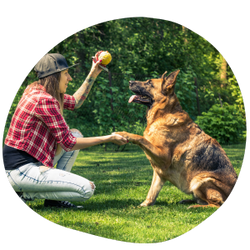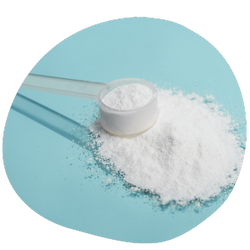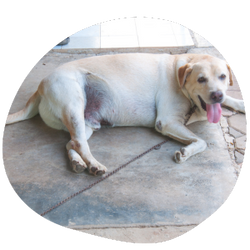No Products in the Cart
Torn Cruciate Ligament in Dogs: Solution, Costs and Reasons

You have probably heard about these conditions: cruciate ligament rupture, torn ACL (anterior cruciate ligament), or cranial cruciate ligament injury. The torn cruciate ligament is the first cause of hind leg limping in dogs. So, let's discover everything about these conditions.
What are cruciate ligaments in dogs?
The dog's knee (also called a stifle) has four main ligaments, like the human's, two collateral and two cruciate, which cross in the middle of the femoral and tibial joint. The crossed ligaments in dogs are called anterior or posterior, according to their respective attachment to the tibia.
Also Read: Dog Hip dysplasia: Symptoms, Treatments and Solutions
Why is there a rupture of the cruciate ligament?
When the rupture of the cruciate ligaments occurs, veterinarians will classify them into two main categories when making the diagnosis: traumatic ruptures, which are brutal, and chronic partial ruptures.
The causes of traumatic ruptures are similar to the ones of the human cruciate ligaments. Athletes are particularly affected: the ligament gives way when sudden pressure is combined with excessive internal rotation. Such a mechanical event is frequent in footballers and skiers. In dogs, traumatic rupture of a cruciate ligament is mainly observed in sporting animals or with accidents such as a bad fall. Animals that are most affected are: hunting dogs, working dogs, falls during races, and cats when they fall from high places.
However, these types of ruptures are relatively rare in dogs. Indeed only 20% are attributable to trauma in dogs.
What is the leading cause of cruciate ligament rupture in dogs?
In this species, the cruciate ligament rupture is sickly and, in 80 % of cases, associated with progressive, chronic lameness and osteoarthritis. Thus, dogs will show signs of cruciate ligament rupture during daily activity. Surprisingly, dogs' actual cause of cruciate ligament rupture remains unknown. But we know that genetics, morphology, environment, immunity, inflammation, and obesity are all predisposing factors.
These chronic partial ruptures happen when the stifle (knee) has a particular structure. Usually, the tibia's end bone shape (a significant tibial plateau slope) is associated with a rupture. This structure increases the ligament's stress to maintain the knee's natural stability. Unfortunately, this continuous stress can lead to rupture of the cruciate ligament.
Also Read: Is Your Dog Prone to Elbow Dysplasia? Symptoms and Best Treatments
Are dogs with a torn ACL prone to have a second one?
We saw that torn ACLs are more often a consequence of a chronic and progressive condition rather than a brutal rupture.
A dog with a one-sided (unilateral) rupture of the cranial cruciate ligament has a 40% to 60% probability of rupturing the other ligament within the year, even if the other knee is stable and not swollen.
Suppose your veterinarian sees fluid in the unaffected knee joint cavity (joint effusion) on an X-ray. In that case, the probability of having a second torn ACL rises to 85% within three years. (Fuller M et al. JAVMA 2014)
Are my dog's breed and age at risk of torn ACL?
On the one hand, cruciate ligament rupture can affect dogs of all breeds and sizes. But large breeds are at higher risk for this joint disease:
- Labrador
- Golden Retriever
- Bernese Mountain Dog
- Boxer
- Rottweiler
- Bulldog
- Newfoundland
- Saint Bernard
- Staffordshire Terrier
- German Shepherd
- Mastiff
They risk rupturing a cruciate ligament three to seven times more than other dogs.
On the other hand, traumatic ruptures occur at any age. Indeed, chronic partial ruptures can develop in individuals at a very young age, sometimes as early as one year old. However, beware as they are often confused with other orthopedic disorders, such as hip dysplasia.

How can I know if my dog has a cruciate ligament injury?
The progressive degeneration of the cranial cruciate ligament will initially result in subtle lameness after activity or discrete weight-bearing on the unaffected limb.
You may also notice:
- difficulty getting up or into the car,
- a change in the way they sit with their knee not properly bent underneath them,
- a decrease in activity,
- a reduction in the muscle mass of the thigh,
- pain when manipulating the knee,
- a "banging" sound (which may indicate a meniscal injury when walking), and
- hardening (swelling/fibrosis) on the inside of the affected knee.
The lameness is more severe and visible when the ligament rupture is complete or a lesion of the meniscus (joint cartilage) occurs.
In the longer term, osteoarthritis (OA) can develop. OA can manifest in many ways, from stiffness on rising to pain and reluctance to play to inactivity and persistent limp. These signs can be more or less severe depending on the day and time of year.
Also Read: What is Dog Bloat or GDV? Symptoms, Causes, Costs, and Photos
How to confirm and diagnose that my dog has a torn ACL?
Veterinarians base the diagnosis on a physical knee examination during a consultation. They will manipulate your dog's knee and might show you a specific and abnormal movement: cranial or anterior drawer sign. It's called that because the knee dislocates similarly to a draw in a dresser.

Swelling and the presence of the drawer are sufficient to establish the diagnosis.
If your veterinarian does X-rays and joint punctures, they may see indirect signs of osteoarthritis.
Finally, arthroscopy, MRI, or CT scan may help confirm the diagnosis. The general veterinarian will refer your dog to a board-certified veterinary surgeon if in doubt.
Should my dog with a torn ACL undergo surgery?
Suppose the diagnosis of a cruciate ligament rupture is sure. In that case, the consensus among veterinarians is to perform surgery, whether you have a kitten, small dog, or large dog.
However, some veterinarians prefer to avoid it in animals under 33 pounds. Be sure to discuss the options with your veterinary specialist, and don't be afraid to ask for a second opinion if necessary.
It's worth noting that medical treatments (anti-inflammatories) alone can bring transitory relief and slow the development of osteoarthritis but do not allow to fix the issue.
We spoke earlier about lesions of the meniscus. So, let's learn about this joint component.
What are the dog menisci ?
The menisci (or meniscus - singular) are two C-shaped "pads" of tough, rubbery cartilage in the knee joint that absorb shocks between the tibia and the femur.

What happens to your dog’s menisci with torn ACL?
In many cases, cruciate ligament ruptures go hand in hand with meniscal injuries. Unfortunately, the altered menisci can cause severe pain that responds poorly to prescribed anti-inflammatory and analgesic drugs. In that case, surgery is the only solution that can restore the animal's comfort and limit the progression of arthrosis.
Furthermore, the absence of meniscal damage is associated with a faster clinical recovery.
What is the treatment of ruptured cruciate ligament in dogs ?
Surgical treatment of dogs with ruptured cruciate ligament
There are two types of surgery :
Classic techniques
They tend to restore knee stability by implanting a prosthesis inside or outside the joint to mimic the role of the deficient ligament. However, the durability of these techniques is not sure in all cases, especially in heavy animals.
Bone or Modern techniques
Veterinarians use bone-cutting techniques (tibial osteotomies) to neutralize tibial thrust by altering the shape of the upper tibia without replacing any ligaments with a prosthesis.
The benefit of these techniques is that, once the bone has healed, these techniques are considered definitive. Unfortunately, tibial osteotomies are not used in cats and rarely in small dogs. However, they are instrumental in heavy (large or obese) dogs.

How much does a torn ACL surgery cost for a dog?
The price will often depend on your area but most of all on the clinic where you do the surgery and whether you work with a board-certified specialist surgeon or not.
For dogs, it can range from $1200 to $4000 per dog knee.
This wide range is due to a potential difference in materials, technique, price of postoperative care (this also impacts the clinic's costs), if there are one or two knees to operate, and many other parameters. Most of all, you should trust your veterinarian's recommendations.
What is your dog's estimated recovery period after surgery for cruciate ligament rupture?
If your dog (or cat) undergoes surgery, a strict eight weeks rest period is mandatory. During these eight weeks, only bathroom outings on a leash are allowed. Crating your pet might be necessary to ensure they don't run around. In addition, veterinary physiotherapies (especially water therapy) are very useful to accelerate and perfect your pet's recovery.
Non-surgical treatment of dogs with ruptured cruciate ligament
Anti-inflammatory drugs with no surgery
Sometimes your veterinarian won't recommend surgery to address your pet's condition. Instead, they will use medications and other therapies to help your pet in these cases. The daily severity of the lameness associated with a cruciate ligament rupture often varies. It worsens with exercise and improves with the use of anti-inflammatory drugs.
While appropriate for lightweight animals, this approach will not benefit heavy pets. Indeed, lameness will persist in the long term in medium and large dogs, and progression of knee osteoarthritis will limit the range of motion and prevent them from returning to their normal activity levels. Therefore the combination of rest and anti-inflammatory drugs is not an ideal treatment for a cranial cruciate ligament rupture in dogs over 33 pounds. But again, it may be appropriate for small dogs or dogs with conditions that prevent general anesthesia.
Should I use hip and joint supplements for my dog after a torn ACL?
We have seen before that torn ACL will lead to osteoarthritis even if surgery allows for a slower onset.
So, veterinary-grade supplements with high-quality ingredients will support your dog's mobility.
Although popular, chondroitin and glucosamine-based supplements have no scientifically proven evidence of results. A majority of studies conclude in the lack of proven results. UC-II© (type II undenatured collagen) based supplements are a great alternative.
Physical rehabilitation after torn ACL surgery in dogs
Studies show that physical rehabilitation can speed your dog's recovery and improve outcomes regardless of the surgical technique chosen.Physical therapy should begin immediately after surgery and usually includes:
- Balance exercises.
- Controlled leash walks.
- Balneotherapy or water activities.
- Other practices will be explained to you by your medical team.
What is the prognosis for cruciate ligament rupture?
Early treatment of a cruciate ligament rupture will lead to a good and excellent recovery and prognosis.
When you delay surgical management, the onset of osteoarthritis influences the prognosis, so we recommend early medical intervention and integration into the treatment plan, physiotherapy and veterinary-grade supplements. Conversely, the absence of meniscal damage is associated with a faster clinical recovery.
Bone surgery techniques such as TPLO (Tibial Plateau Leveling Osteotomy) and TTA (Tibial Tuberosity Advancement) allow a faster clinical recovery than ligamentoplasty (classical surgery techniques). In all cases, physiotherapy and veterinary-grade supplements allow faster recovery and optimize the postoperative clinical course.
We hope this article helped you understand better dog cruciate ligament rupture. If you have experience with such a condition, we'd love to hear from you. So, please share your story with us!
FAQ
What to expect after cruciate ligament surgery in dogs?
After cruciate ligament surgery, most dogs need strict rest for several weeks, followed by a gradual return to activity. Swelling, limited mobility, and discomfort are normal early on. Your vet may recommend physical therapy, joint supplements, NSAIDs, and controlled walks to support healing. Full recovery can take 8 to 12 weeks or longer, depending on the dog’s age, weight, and overall health. Follow-up visits are essential to monitor progress and avoid complications.
What happens if you don't fix a dog's cruciate ligament?
If a torn cruciate ligament is left untreated, the joint becomes increasingly unstable. This can lead to chronic pain, loss of mobility, muscle loss, and long-term arthritis. Dogs often shift their weight to the other leg, increasing the risk of injury on that side as well. Veterinary treatment is essential to manage pain and prevent further damage.
Can a dog walk on a torn cruciate ligament?
Some dogs may still walk with a torn cruciate ligament, but they will often limp or show signs of discomfort and pain. This can be misleading, as walking does not mean the injury is minor. Continued movement on an unstable joint causes more damage, so it's important to see a veterinarian for proper diagnosis and treatment.
















Leave a comment